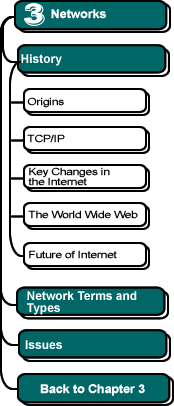

|
Internet Growth: the 1980s
- 1983: 500+ hosts
- 1984: 1000+ hosts
- 1984: original NSFNet backbone—56,000 bits (56 kilobits) per second.
- 1986: 2000+ hosts
- 1987: somewhere between 10,000 and 25,000 hosts
The Internet was growing so quickly that in 1987, only three years later, the NSF had to upgrade the NSFNet backbone to a "T-1" line—1.5 million bits (megabits) per second.
Here, the Internet was running into the issue of "bandwidth."
 Bandwidth
refers to the amount of information that can travel over a network connection
in a given amount of time. One of the common analogies invoked to describe
bandwidth is that of a pipe: a pipe with a larger diameter
can carry more water in one minute than a narrower pipe can. Similarly,
the many network connections that make up the Internet come in a great
variety of bandwidths—that is, some can carry more bits
per second (bps) than others. By definition, a backbone must
have a very high bandwidth relative to other kinds of connections.
Bandwidth
refers to the amount of information that can travel over a network connection
in a given amount of time. One of the common analogies invoked to describe
bandwidth is that of a pipe: a pipe with a larger diameter
can carry more water in one minute than a narrower pipe can. Similarly,
the many network connections that make up the Internet come in a great
variety of bandwidths—that is, some can carry more bits
per second (bps) than others. By definition, a backbone must
have a very high bandwidth relative to other kinds of connections.
The original NSFNet backbone could not handle the packet traffic generated by the growing number of hosts on the Internet. Thus, it had to be upgraded to a higher bandwidth.
![]()
![]()
This chapter was written by Jeff Nyhoff and Joel Adams. Copy editing by
Nancy Zylstra
©2005 Calvin University (formerly Calvin College), All Rights Reserved
If you encounter technical errors, contact computing@calvin.edu.